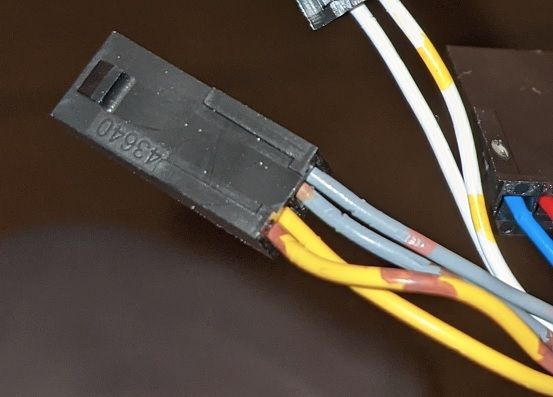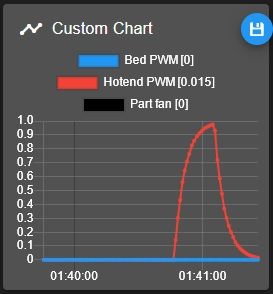PWM limit not appying for new hotend
-
Hi all,
I have just installed a Goliath hotend on my Voron which is capable of pulling 100w (at 24v). I'm using a multicore Igus cable to the printhead. It has cores with a nominal cross section of "0.34" I assume this is 0.34mm². I have always doubled up 2 cores for the heater. As in the photo below.

I'm still not sure about running this amount of current through them, and I think I may be pushing the limits of my PSU already so I have set the PWM limit to 60%, which matches my old E3D 60w heater core using the following M307 command:
M307 H1 B0 S0.6However when I start heating the hotend, the reported PWM value flys way past 0.6, as if still set to 1.0.

I have a PWM limit on my bed of 0.8, and that seems to work perfectly.
What could I be doing wrong here?
-
@Threepwood have you PID ed you hot end yet as the M307 should more like this
M307 H0 R0.838 K0.331:0.000 D3.08 E1.35 S0.90 B0 -
@moth4017 I came back to confirm that I have now run a PID tune at 0.6PWM and it is now capped at 0.6.
I do feel it might be safer for the M307 S command to be an absolute limit regardless of PID.
Thanks for the help though.

-
Could anyone weigh in on the limits of this cable gauge? The cable is probably about 1.5m - 2m long. This is the full spec on the Igus website https://www.igus.co.uk/product/CF240_PUR?artnr=CF240.PUR.03.18 Remember I'm using 2x2 cores for the heater.
I tried a few online calculators and got different results, some saying 100W (24v, 4.17amps) should be okay, and others saying it would not.
-
@Threepwood
is the cable length from the Power supply to the heater and back to the Power supply 2M?
-
@moth4017 No, the cable is 1.5 - 2m. So the full run would be 3 - 4 meters. Probably closer to 3 meters.
-
@Threepwood
2 x 1,5mm^2 1% voltage dropor with a 2% voltage drop 2 x 0,75mm^2
-
So I'm slightly pushing the limits of 0.68mm^2 at full power. I'll keep that in mind. Thanks!
-
@Threepwood Just a couple of things to be aware of. A low PWM value will not prevent temperature runaway of an over powered heater if a MOSFET fails. So it should not be used as a safety measure. Also, PWM does not limit the current - it only limits the time that current is applied. So wires should be sized accordingly and be capable of taking the maximum current.
-
Hi @deckingman. I've watched a few of your YouTube videos. Your new build looks very professional!
Do MOSFETs often fail closed? And are they they last line of defence on Duet boards? It was always the SSR on my bed that had me slightly worried about a failure, but I am using a thermal fuse at least.
I think with 0.68mm^2 of wire, the cables shouldn't overheat even at full power, although it does seem to be borderline. If I was building from scratch, I would choose a thicker cable. I have 2 spare cores in the multi-strand cable now, due to switching to external cooling. So I may re-crimp with 2x3 cores in the future.
Surely the main issue with using undersized cables would be the cable heating beyond working temperature? In which case, a lower PWM would solve this issue wouldn't it?
-
@Threepwood do you have a heated chamber? if not you should be ok
-
@Threepwood AFAIK, MOSFETs have an equal chance of failing open or closed. Also remember that PWM only kicks in as the actual temperature approaches the set temperature. During the initial heating phase, the heater will be fully on. Thermal fuses can become detached or fail too. Component failures may be rare but the consequences of a failure could burn your house down. That's why I would never use an overpowered heater. But it's up to you what level of risk you are comfortable with.
-
@moth4017 No, it's not actively heated and only reaches about 50°C.
@deckingman This particular hotend, the Goliath by Vez3D for the VZbot is only available in 100W. It's capable of 500°C (once you take the sock off) and I'm using it with an external CPAP fan, which is capable of cooling the nozzle itself a lot. So it needs all that power to hold temperatures when the CPAP fan is run at high settings.

When a PWM limit is set in M307, the hotend won't be PWM above that limit, even at first heat up. As long as you have run a PID tune at the requested PWM limit, as I found out earilier in this thread thanks to @moth4017.
Although DWC did warn me that this hotend could reach 770°C. I might try setting things up so that the CPAP fan will run at 100% if a heater fault is detected. Not the best way to mitigate an overheating hotend, but better than nothing for now.
-
@Threepwood Seems a bit cock-eyed to me - having to use an over powered heater to compensate for over powered or misdirected part cooling air. But like I said, if you are happy to accept the risks, then it's none of my business - I'm just pointing them out. Oh and talking of risks, the melting point of aluminium is 660 deg C (just pointing it out since you mentioned that the hot end could potentially reach 770 deg C).
-
@deckingman In my case, I designed the duct myself for my custom printhead. I ran CFD on it, so I'm happy with where the air is directed. But the CPAP fan at full speed is in another league compared to normal part cooling fans, so there is only so much "containment" of air flow we can do. See the first 15 seconds of Vez3D's video on it. https://youtu.be/E3kBau82SwU?si=skFc90h_gz5UPpWB
He is running his at amazingly high speeds, and even uses extra blowers that direct air from the sides of the print area, which he needs for the high speeds he is running. See this video, it's absolutely astonishing. https://youtu.be/hcMxEkVvIdE?si=Zz3FRlIIbShGoVR1&t=580
So I don't think there is any other option than to use these high powered fans.
I'm running things a bit slower, so I don't need the full power at the moment. But it's nice to know it's there if I do, or if I decide I want to print PLA.
Thankfully the there's no aluminum in the hotend, it's full copper and nichrome. Although the silicone sock would be problematic. The heatbreak is water cooled, so as long as the pump doesn't stop at the same time, the aluminium above the heatbreak wouldn't melt.